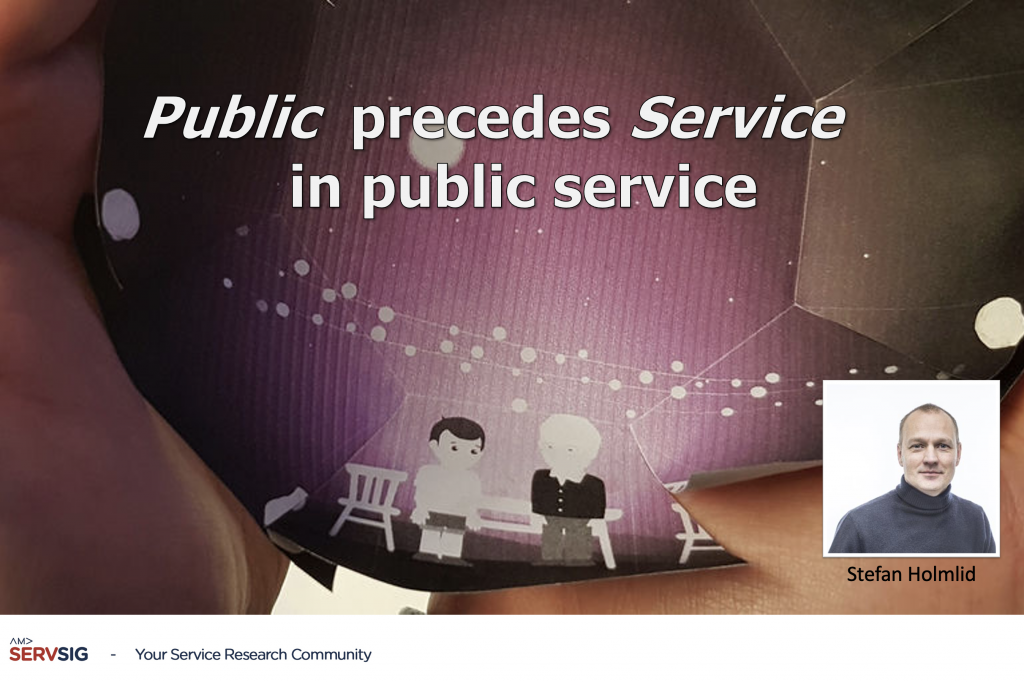Guest article by Stefan Holmlid.

In 2021, we celebrated a centenary of suffrage in Sweden. It was a three-year long celebration, covering the century since the decision to the century since the first election. To mark this auspicious occasion, Linköping University hosted a seminar series on how design and democracy have been interwoven during those hundred years (1). Stepping back and reflecting on those seminars, the interviews and preparations we undertook in making them, it struck me there are connections to service and service research. So, some of the figures of thought from the series resonated with me, especially around public service. Being a design researcher, the design field will be my point of departure, probably passing over things that are common knowledge in the service research field. As a design researcher, an approach with critical claims is an opening to work with generative and constructivist research processes, where pre-figuration, interventions and speculations are common (2). The claims made in the text should be seen as provisional and as invitations to articulate challenges to future research work. I am curious to hear from others, what has been done and what could be pursued.
It is tempting to think of public service in similar terms as we do other classes of services, through the dominant service logics from marketing and management. Therefore, it is challenging to claim that doing precisely that, is a questionable approach to public service. Based on this claim, I will outline some guiding principles, for the benefit of public service research. Deliberately there is friction between and idiosyncrasy among the principles, as well as a dynamic interplay within and between them.
Public service is not a market.
This is fundamental. As soon as we define, identify or articulate public service, we are at the same time saying that it is not a market. Of course the actual services provided are sometimes situated in a space similar to a market, but this is a superficial construct of philosophies of governance, often referred to as mixed economies or quasi-markets (3). Sometimes, there may be a side-market to public service, but the services in that parallel space are then not public. The consequence is that market-based logics do not apply to public service, or at the very least, research needs to show that these market-based logics are meaningful and good for public service and not only act as a driver to marketify public service. Additionally, a challenge for service research is to find alternatives to the dominance that market-based thinking exerts on the field.
Rights precede service.
Any service in the public service sphere is based on rights. Some of these rights are made part of what is sometimes referred to as the societal contract. This is a conceptual contract that has been developed over many years, sometimes in slow and meandering adaptation. One way of thinking about this is that public services are the means for citizens to access these rights. This is implemented operatively through organizations funded by taxes and governed through the (democratic) public sector system. It does not mean that each individual at every point in time is entitled to every public service, but anyone may at some specific point in time be entitled to a specific public service. From a rights perspective, this should be equal to all. Related to the limitations of market logics, there is an interesting difference here between equality of opportunity and equality of outcome that could be further explored in service research. A consequence of allowing rights to precede service is that the concept of co-creation of value is too limited. A challenge for service research is to develop an alternative, or extended concept, the co-creation of rights, as well as developing knowledge on how institutionalization of those rights can occur through every act of co-creation.
Policy is enacted.
Policies, seen as instruments to govern organizations to support the fulfilment of citizen rights, are often referred to in service research settings as being on the macro-level. Doing so can be criticized for reducing policy into an object. However, from a constructivist point of view on public service, policy is not bound to any specific level. Policy is so imbued that it transcends system levels and occurs in any and all enactments of public service. The policy seen as an “object”, then becomes a boundary object for participants in those enactments. In each enactment, society is more or less cocreated and confirmed. The enactments of public service become interventions into policy making itself. The multiple nature of policy, as an object of governance, a boundary object, and participatory enactments, is prominent in public service in a way it is not in other sectors. A challenge for service research is to be able to span the fields of governance and enactment, in a constructivist manner.
Publics are created and reproduced.
When referring to “public” in public sector, one is usually referring to everyone in a society. But there is also the conceptualization of publics based on John Dewey, where there is a juxtapositioning of the institutionalized state and the participatory democracy embedded in society (4). There is also the idea about commons by Elinor Ostrom that are societal phenomena but not necessarily part of the formalized structures of the state, although some are governed by laws (5). Any institutional construct of a public is meaningfully upheld only through the citizens being active in their relation to those constructs. Whatever perspective on “publics” we choose, they are created and under recurring reproduction. This is based on an assumption that the inhabitants in a society change, through ageing, education, migration etc. and that the organized society also is in transformation. Moreover, there are publics created in society that are on the fringe of the (welfare) state. These are part of intervening into societal transformation, and some become integrated into the formalized parts of society. A challenge for service research is to develop an understanding of such systems of publics, and their interplay with institutionalized public services and innovation in and of publics.
Public is not institutional.
Institutional paradigms abound in service research, for good reasons it seems, from a theoretical as well as phenomenological point of view. It may even be argued that research on public services would benefit from using an institutional perspective. However, the concept public should also be understood as relational, without the limitations of the institutional lens. While an institutional lens promotes e.g., extrinsic factors, power asymmetry, services and service quality, it marginalizes aspects such as resourcefulness and service equity. It could even be argued that focusing on service quality without first understanding equity, is to fail the public purpose. Non-institutional approaches would invite for new and more nuanced exploration of phenomena and concepts such as emergence, resilience, value co-creation, poly-centricity, resourcefulness, pluralism. A challenge for service research is to find alternative ways of understanding publics that are not assuming an institutional perspective, covering theories with advanced systemic roots as well as theories that are non-systemic.
Now, this is not a claim that there has not been any research on these aspects. There has been research supporting and criticizing New Public Management (6). There has been research applying and adapting the service logics to the public sector (7). There is the initiative around Transformative Service Research (8). There has been research on designing for pluralism in public service (9). However, I believe more work is needed based on alternative principles, such as the ones presented here, rather than repeating, reproducing, and reinforcing current dominant ideas. Moreover, the research that already has been done with alternate perspectives and principles needs to be revisited and revitalized.
The coming years, this is precisely what I will engage in, with a design researcher’s approaches and methods.

Stefan Holmlid
Professor in Design,
Department of Computer and Information Science, Linköping University, Sweden
1) If you are curious about the seminars, they can be found here.
The two last ones, “The politics of design, and the design of politics” and “Visions for the future” are in English, the two first are in Swedish “All roads lead here” and “Creative citizens”.
2) Karpen, I. O., Holmlid, S., & Yu, E. (2021). Service design in the context of complexity: Moving between plurality and tension towards a future research agenda. International Journal of Design, 15(3), 1-10.
Redström, J. (2017). Making design theory. MIT Press.
3) Ferlie, E. (1992). The creation and evolution of quasi markets in the public sector: A problem for strategic management. Strategic Management Journal, 13(S2), 79-97.
4) Dewey J (1954 [1927]) The Public and Its Problems. Athens, OH: Swallow Press.
5) Ostrom, E. (2000). Reformulating the commons. Swiss Political Science Review, 6(1), 29-52.
6) Skålén, P. (2004). New public management reform and the construction of organizational identities. International Journal of Public Sector Management.
7) Osborne, S. P. (2018). From public service-dominant logic to public service logic: are public service organizations capable of co-production and value co-creation?. Public Management Review, 20(2), 225-231.
8) Anderson, L., Ostrom, A. L., Corus, C., Fisk, R. P., Gallan, A. S., Giraldo, M., … & Williams, J. D. (2013). Transformative service research: An agenda for the future. Journal of Business Research, 66(8), 1203-1210.
9) Caic, M., Holmlid, S., Mahr, D., & Odekerken-Schroder, G. (2019). Beneficiaries’ view of actor networks: Service resonance for pluralistic actor networks. International Journal of Design, 13(3), 69-88.

